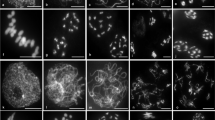Abstract
Comparisons were made between two kinds of tetraploids derived from the hybrid Lolium temulentum x L. perenne. One hybrid behaves like an autotetraploid with multivalents at first metaphase of meiosis in pollen mother cells. The other behaves like an allotetraploid, in which pairing at first metaphase is restricted to bivalents comprised of strictly homologous chromosomes. The “diploidisation” of the latter form is controlled by determinants located on both the normal, A chromosomes and on supernumary B chromosomes. Reconstruction of synaptonemal complexes and their elements, from serial sections through pollen mother cell nuclei examined under the electron microscope, reveals that at zygotene pairing in both forms results in multivalent formation involving non-homologous as well as homologous chromosomes. The mechanism responsible for the diploidisation is, therefore, not based on a restriction of pairing at early meiosis to homologous chromosomes but on a “correction” or transformation of the multivalent chromosome associations to bivalents subsequent to zygotene. The transformation is not completed until late pachytene. In the multivalent-forming tetraploid a maximum of four chromosomes are associated at first metaphase. Yet configurations of a higher valency are found at zygotene. There is, therefore, a partial transformation of multivalents even in this autotetraploid form which restricts configurations at metaphase I to homologous and homoeologous chromosomes only. In both hybrids some homologous bivalents are not the product of resolution of multivalents but result from two-by-two pairing from the beginning of zygotene.
Similar content being viewed by others
References
Evans GM, Macefield AJ (1973) The effect of B chromosomes on homoeologous pairing in species hybrids I. Lolium temulentum x Lolium perenne. Chromosoma 41:63–73
Feldman M (1966) The effect of chromosomes 5B, 5D and 5A on chromosomal pairing in Triticum aestivum. Proc Natl Acad Sci USA 55:1447–1453
Givens JF, Phillips RL (1976) The nucleolus organiser region of maize (Zea mays L.). Ribosomal RNA gene distribution and nucleolar interactions. Chromosoma 57:103–117
Henderson SA (1970) The time and place of meiotic crossing-over. Annu Rev Genet 4:295–324
Hobolth P (1981) Chromosome pairing in allohexaploid wheat var. Chinese Spring. Transformation of multivalents into bivalents, a mechanism for exclusive bivalent formation. Carlsberg Res Commun 46:129–173
Hutchinson J, Rees H, Seal AG (1979) An assay of the activity of supplementary DNA in Lolium. Heredity 43:411–421
Jenkins G (1983) Chromosome pairing in Triticum aestivum cv. Chinese Spring. Carlsberg Res Commun 48:255–283
Jenkins G (1985a) Synaptonemal complex formation in hybrids of Lolium temulentum x Lolium perenne (L.) I. High chiasma frequency diploid. Chromosoma 92:81–88
Jenkins G (1985b) Synaptonemal complex formation in hybrids of Lolium temulentum x Lolium perenne (L.) II. Triploid. Chromosoma 92:387–390
Navashin M (1934) Chromosome alterations caused by hybridization and their bearing upon certain general genetic problems. Cytologia 5:169–203
Rasmussen SW, Holm PB (1979) Chromosome pairing in autotetraploid Bombyx females. Mechanism for exclusive bivalent formation. Carlsberg Res Commun 44:101–125
Seal AG, Rees H (1982) The distribution of quantitative DNA changes associated with the evolution of diploid Festuceae. Heredity 49:179–190
Taylor IB, Evans GM (1977) The genotypic control of homoeologous chromosome association in Lolium temulentum x Lolium perenne interspecific hybrids. Chromosoma 62:57–67
Thomas HM (1981) The Giemsa C-band karyotypes of six Lolium species. Heredity 46:263–267
Author information
Authors and Affiliations
Rights and permissions
About this article
Cite this article
Jenkins, G. Synaptonemal complex formation in hybrids of Lolium temulentum x Lolium perenne (L.). Chromosoma 93, 413–419 (1986). https://doi.org/10.1007/BF00285823
Received:
Issue Date:
DOI: https://doi.org/10.1007/BF00285823




